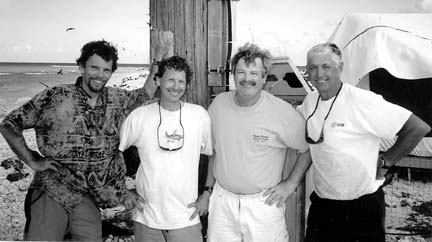
COURTESY OF NATIONAL MARINE FISHERIES SERVICE
The National Marine Fisheries Service has installed two remote cameras on French Frigate Shoals in the Northwestern Hawaiian Islands to take dawn-to-dusk photos of nesting green sea turtles. Members of the team involved in the research are, from left, Konrad Schaad and Daniel Zatz of SeeMore Wildlife Systems; George Balazs, marine turtle research program leader, National Marine Fisheries Service; and Marc Rice, marine biology teacher at the Hawaii Preparatory Academy.
Nesting turtles to
get taste of Big BrotherHigh-tech tools will let
isle scientists peer in on wildlife
at remote reaches of the islands
Scientist George Balazs has new high-tech tools to study green sea turtles in the Northwestern Hawaiian Islands -- two remotely operated video cameras.
Mounted on a 65-foot pole in the middle of East Island in the French Frigate Shoals in June, the specially designed cameras are programmed to take still photos and video at 39 different locations on the 12-acre island once an hour from daylight to dusk.
The cameras are akin to those used for building security but with better resolution, said Balazs, a National Marine Fisheries Service researcher who has studied green sea turtles for 30 years.
His research has shown that 90 percent of the green sea turtles in Hawaii nest at French Frigate Shoals, of which half nest at East Island. The French Frigate Shoals are an atoll about 500 miles northwest of Honolulu.
The new cameras increase scientific observation of turtles to a daily basis from the 30 to 45 days a year that researchers are able to visit.
"The potential for this and its promise are absolutely magnificent," Balazs said. "It's cutting-edge, 21st-century stuff that's just beginning to see its day. I'm delighted we can bring it to Hawaii."
For now the data from the cameras is relayed to a U.S. Fish and Wildlife Service station about six miles away at Tern Island and researchers there send Balazs CDs of the photos by airplane.
Next spring, Balazs hopes to get a satellite link that will enable him to control the cameras from his computer at the Pacific Islands Fisheries Science Center in Honolulu.
Ultimately, Balazs hopes that scientists, students and educators will be able to turtle watch via the Internet from anywhere in the world.
But even before the satellite uplink, students at the Hawaii Preparatory Academy on the Big Island will use data gathered through the cameras for their ongoing Marine Turtle Research Program. Marine science teacher Marc Rice and his students have served as research assistants for Balazs on the Kona Coast since 1987.
The cameras, which cost about $28,000 total, were specially designed by SeeMore Wildlife Systems Inc. of Homer, Alaska. They run off solar energy and include features like mini-windshield washers to keep the camera lenses clean.
Sea turtles are not the only possible study subject either. Already scientists are looking at the movements of Hawaiian monk seals on East Island. There is talk of tracking coastal erosion and of observing sharks and sea birds.
"There's a whole new world available to us now," said Don Palawski, Fish and Wildlife Service refuge manager for the Pacific Remote Islands National Wildlife Refuge Complex.
"We could have remote surveillance cameras at other islands that don't have people on them. It would work not only to look at wildlife there, but to use as an enforcement tool to make sure people don't come on the islands."
�
